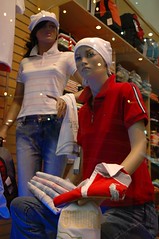Hey Borat-lovers: Ponder this New Yorker Shouts & Murmers essay by George Saunders, which in its way raises a question or two about whether the movie challenges, or merely panders. Something to think about, is all. And it’s funny, as Saunders always is.
Posted Under:
Uncategorized
This post was written by Rob Walker on November 30, 2006
Comments Off on “Rich Social Commentary”
Pretty interesting writeup in in the NYT today about the Museum of Contemporary Art Detroit:
Housed in an abandoned car dealership on a barren strip of Woodward Avenue, it fits loosely into a decades-long effort to restore energy to an area that was abandoned during the white flight of the 1970s.
But the design springs from a profound rethinking of what constitutes urban revitalization. Designed by Andrew Zago, its intentionally raw aesthetic is conceived as an act of guerrilla architecture, one that accepts decay as fact rather than attempt to create a false vision of urban density. By embracing reality, it could succeed where large-scale development has so far failed.
And later:
For the opening of the museum, the graffiti artist Barry McGee spray-painted the brick facade with bold swirling letters. The graffiti echoes the colorfully painted convenience stores with Lotto signs that have sprouted up around Detroit in former brick bank buildings. (The city’s planning department tends to regard the signs as a form of architectural vandalism.)
I’ve never spent any time in Detroit, despite having wanted to for years. Maybe in ’07. Here’s the whole article. Here’s the museum’s site.
Poketo, a Consumed subject in August of this year, co-presents a group show in Houston, “You’re a serpent; and there’s no use denying it.” It’s at Domy Books, 1709 Westheimer, opening Friday night December 1. Details here or here.
There’s also a Poketo show in San Francisco, but I’m always a little more excited to hear about things like this happening in the Space City.
Posted Under:
Subculture Inc.,
To Do,
Update
This post was written by Rob Walker on November 29, 2006
Comments Off on To Do In Houston December 1
Gabriel Urist, partial subject of a Consumed back in June, is opening his own space, Gabriel Urist Worlds Fair (204 Elizabeth Street, Basement) in NY. Looks like there’s an opening event Thursday night, Nov. 30. Info via Mr. Urist, and Freshness, where you can find the details.
Posted Under:
Flickr Artifacts
This post was written by Rob Walker on November 28, 2006
Comments Off on Flickr Interlude
 So what about this whole “Red” thing? I guess it’s called “Product Red.”
So what about this whole “Red” thing? I guess it’s called “Product Red.”
I’m sure you’ve come across it some place or other. Motorola, Apple, The Gap, and other companies have these special red products, see, and when you buy them, some of the money goes to “fight AIDS in Africa.”
There was an issue of The New Yorker not long ago that was jammed with Gap “Red” ads, most of them featuring some celebrity or other. Reader Marc A. sent me a thoughtful note about this recently, focused mostly on the Gap’s use of the Red thing:
I asked a handful of people immediately what they knew of the GAP ads, and most had it right. It was a chance to do something because most of us wring our hands in apathy. But if there’s a constant vibe out there contending “What can I do about African poverty?” which is passive and sad and I understand it because I am it, there’s also this acceptance of a campaign by GAP which is equally passive: “At least the movie stars are doing something about it.” EW!
Read more
Here’s another quick update on Barking Irons: Recently the brand reached out to Friends of the Highline, the nonprofit that’s been involved in restoring and revamping and re-opening to the public a strip of what used to be an elevated rail track built mostly in the 1930s. (Here’s more on all that.) It’s one of the more widely discussed urban-renewal kinda projects of recent years. Anyway, the Barking Irons guys approached the with some ideas for some T’s, that (per the brand’s method) draw in history; with proceeds going to Friends of the Highline. One of those above (they’re at Barneys and the brand’s site) and info below…
I hope to have an update on what’s up with the Hundreds soon, as well.
I don’t want to say that I’m cyncial about advertising creeping into places it does not belong (particularly thanks to the supposedly empowering wonders of technology), but let’s just say it’s hard to surprise me. This did:
Last month, FoxNews.com ran an article about Republican House Speaker Dennis Hastert’s postelection prospects. In the story, the words “house,” “speaker” and “leadership” were underlined twice.
The underlines weren’t for emphasis — they were clues that those words were doubling as advertisements. When readers moved their cursors over the underlined words, a pop-up advertisement would appear, obscuring some of the text of the article. The ad above the word “speaker,” for instance, was for the search engine Ask.com. “Search Ask.com for Speakers,” it said, and linked readers to the site.
This doesn’t need to be said, there may be no point in saying it, but let me just say: That’s so, so wrong.
Here’s the WSJ story.
Posted Under:
Advertising
This post was written by Rob Walker on November 27, 2006
Comments Off on Ads in the news. Literally.
In Consumed: The Rachel Ray Sucks Community: Getting together to share and form a community — of dislike.
Consumer culture, and indeed popular culture, revolve in large part around shared admiration, shared likes: fandom, in a word, is a thing that can bring us together. But what about shared dislikes? Can a community form around that? What is the opposite of a fan club? The answer is the Rachael Ray Sucks Community. Gathering by way of the blogging and social-networking site LiveJournal, this group has more than 1,000 members, who are quite active in posting their latest thoughts and observations about the various shortcomings, flaws and disagreeable traits of Rachael Ray, the television food personality. “This community,” the official explanation reads, “was created for people that hate the untalented twit known as Rachael Ray.” The most important rule for those who wish to join: “You must be anti-Rachael!” ….
Continue reading at the NYT Magazine site via this no-registration-required link.
Additional link: Rachel Ray Sucks Community.
The New York Times reports:
Shortly after midnight yesterday, an estimated 15,000 shoppers pushed and shoved their way into the Fashion Place mall in Murray, Utah. Police soon joined them, responding to reports of nine skirmishes.
Once inside, shoppers ransacked stores, overturning piles of clothes as they looked for bargains. A retailer’s dream — too many customers! — quickly turned into a nightmare, forcing store clerks to shut their (clomid) doors, and only let people in after others left. The mall even briefly closed its outside doors to avoid a fire hazard.
And:
At the Wal-Mart outside Columbus, customers dashing toward 5 a.m. deals pinned employees against stacks of merchandise.
“Oh, my god, stop pushing me, oh, my god,” screamed Linda Tuttle, a 47-year-old employee at the store.
A TV newscast in Virginia reports:
The rush at Roanoke’s Best Buy turned violent, just seconds after the doors opened at 5 a.m. NewsChannel 10 caught a man on video hitting someone over and over. Watching in slow motion you can see him hit someone at least 5 times.
A Scranton newspaper reports:
The scene at many stores was part Woodstock, part Lord of the Flies, as hundreds hunkered for hours bundled in clothes, wrapped in blankets and holding coffee cups and crumbled newspaper inserts.
As the 5 a.m. opening at Best Buy approached, latecomers crashed the line marked by yellow tape, jockeying for pole position with people who stood in the cold for hours.
Attempting to quell the crowd, a store manager jumped on a garbage can and threatened to call police. Store employees handed out tickets, entitling the bearer to one of the limited number of so-called “doorbuster” items.
Many of those in the line circling the building had no idea that the front of the store was on the brink of chaos, or that items they waited for were already claimed.
In Torrance, California, the Mercury News reports:
An elderly woman and nine other bargain hunters were injured Friday in a rush for gift certificates dropped from the ceiling of a local mall.
Some 2,000 shoppers rushed for 500 falling prize-filled balloons at the Del Amo Fashion Center, leaving nine with minor wounds and sending an elderly woman to the hospital.
This is from an interesting set, described by the photographer as having been taken on Kish Island, which is off the coast of Iran. The photographer, who I gather lives in Iran, writes that “The island is called ‘the cosumers’ paradise,’ due to its status as a free trade zone, with numerous malls, shopping centres, tourist attractions, and resort hotels.” (Not being familiar with Kish Island, I did a cursory web search; this site describes it as “the closest thing to a posh beach resort Iran has to offer.”)
The set, then, is entirely shots of mannequins in the island’s malls. “As an unwritten rule,” the photographer points out, “all the mannequins’ heads had to be covered.”
Posted Under:
Flickr Artifacts,
Retail
This post was written by Rob Walker on November 23, 2006
Comments Off on Flickr Interlude
 The most prominent blurb in this print ad for Lee Siegel’s new book Falling Upwards seems pretty impressive: “One of the country’s most eloquent and acid-tongued cultural critics.” And it’s from The New York Times Magazine. Wow! So I guess The Times Magazine must have run some kind of piece about what an amazing critic and writer Siegel is, annointing him one of the antabuse greats.
The most prominent blurb in this print ad for Lee Siegel’s new book Falling Upwards seems pretty impressive: “One of the country’s most eloquent and acid-tongued cultural critics.” And it’s from The New York Times Magazine. Wow! So I guess The Times Magazine must have run some kind of piece about what an amazing critic and writer Siegel is, annointing him one of the antabuse greats.
Actually, not so much. The Times Magazine ran a Q&A with Siegel that was focused almost entirely on the fact that he had been caught trashing his critics and breathlessly praising himself under a fake name in the comments section of his blog for The New Republic. The full context of the blurb was this opening question of that interview:
Q: As one of the country’s most eloquent and acid-tongued cultural critics, what is it like to be so sharply criticized in public yourself? Your blog for The New Republic was terminated this month after you deceived readers, using a pseudonym to post comments in which you belittled your enemies and praised yourself as “brave, brilliant and wittier than [Jon] Stewart will ever be.”
Too bad he didn’t use that last quote in the ad: “‘Lee Siegel is brave, brilliant, and wittier than Jon Stewart will ever be.’ — Lee Siegel.” (Or the ad could have used the question in the interview that I most enjoyed: “‘What are you talking about?’ — The New York Times Magazine.”)
But short of that, I guess (https://newprovortho.com/accutane-isotretinoin/) using a line that would never have appeared in print had it not been occasioned by one’s own spectacular ethical and professional lapse is impressive in its own way. And a good example, actually, of having what it takes to fall upwards.
Posted Under:
Blurbs
This post was written by Rob Walker on November 23, 2006
Comments (1)
Posted Under:
Flickr Artifacts
This post was written by Rob Walker on November 22, 2006
Comments Off on Flickr Interlude
Rather early in the life of Consumed, I had a column in which I used the phrase, “the tyranny of Good Design,” and observed that, sometimes, it feels as if every object you’ve ever owned, no matter how mundane, will need to be replaced simply because it’s not stylish enough, and fails to express Who You Really Are.
The latest example, via Popgadget: “These charming Snake Bike Locks sold by Pylones are a wonderful way to differentiate your bicycle from the countless masses.”
That’s something you need to do. You need to differentiate your bicycle from the countless masses. Only $27.
One of the most interesting brand-specific blogs that I’m aware of is StarbucksGossip.com. Its proprietor is Jim Romenesko, who has a couple of other blogs you may have come across. He knows what he’s doing! (You may not have come across one of his pre-blog-era projects, Death Log, but that’s really cool, too.) Anyway, he was kind enough to answer a few questions as part of Murketing.com’s ongoing series of brand-blog Q&As. Here goes.
Why Starbucks? There are any number of chains or companies out there to blog about, what was it about Starbucks in particular that made you say, “I should do this.”
I frequent Starbucks stores in the metro Chicago area (and occasionally in Wisconsin) on a daily basis. I overhear discussions between baristas and employees that are sometimes interesting and not typical of a customer-clerk relationship (they’re usually more personal). I thought it would be interesting to move those conversations to the web, and toss in commentary from Starbucks critics, too.
Starbucks has more diehard fans and haters than any company I know, so I figured the online discussions would be passionate and occasionally raucous. I was right. Some of discussions about Starbucks are serious and should be read by management — the issue of high-sugar/high-fat/trans-fat products, for example.
Read more




 "
"























 Kim Fellner's book
Kim Fellner's book  A
A